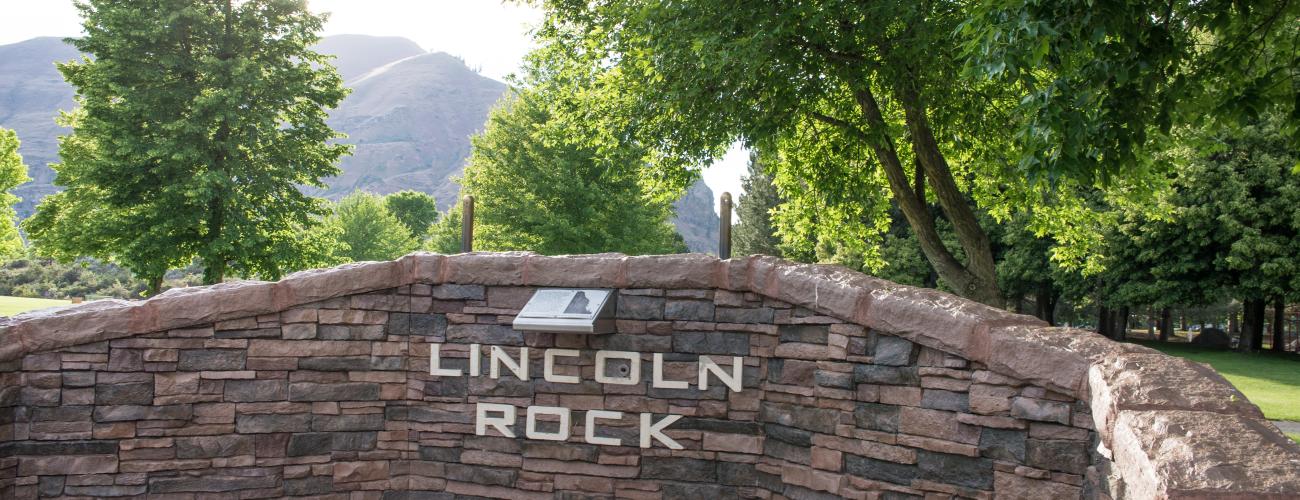Lincoln Rock State Park History
Lincoln Rock State Park is a popular recreation area with access to Lake Entiat, the reservoir created by Rocky Reach Dam.
Indigenous Lands
The park lies within the traditional territories of Sahaptian and Interior Salish Indigenous people whose present-day descendants include members of the Confederated Tribes and Bands of the Yakama Nation and the Confederated Tribes of the Colville Reservation. For thousands of years this area has provided habitat for a diverse community of life that forms the basis of their cultures.
Some tribal representatives ceded ownership of the area to the US federal government under duress in the Yakima Treaty of Camp Stevens in 1855, keeping rights to harvest natural resources in their usual and accustomed places, including the Columbia River. Other tribes and bands such as the Columbia-Moses (Sinkayuse) were subjected to a series of executive orders by US Presidents that established and dissolved reservation areas and ultimately relinquished ownership of their homelands to the US federal government.
Government surveys were completed in 1884 and the land in today’s Lincoln Rock State Park passed into private ownership when it was granted to the Northern Pacific Railway (NP) in 1895, part of nearly 40 million acres of public lands granted to the railroad by the US federal government to subsidize construction of the line. As with most of its granted lands, the NP sold this parcel to another private landowner. Ownership eventually passed to the Chelan County Public Utility District (PUD).
A Face in the Cliff
The park’s namesake is an erosional feature that resembles the profile of a human face. It can be seen in an outcrop of the 90-million-year-old Swakane Gneiss rock formation, located on the opposite side of the valley from the park across the Lake Entiat reservoir.
In 1898, Charles H. Schoff took a photo of the rock from the deck of the Echo, a Columbia River steamboat that ran between Wenatchee and Orondo, on which he served as an engineer. Ed Ferguson, a deckhand on the boat, was reading a biography of Abraham Lincoln, and remarked that the face in the rock resembled the late president. Over time, the feature became known to crew members and passengers as Lincoln Rock.
In the July 1902 issue of The Ladies Home Journal, a photograph of Lincoln Rock taken by M. P. Spencer was published as part of an article titled “Rocks That Have Faces on Them,” leading to nationwide recognition.
Rocky Reach Dam
Rocky Reach Dam impounds the Columbia River just downstream from Lincoln Rock State Park. Chelan County PUD oversaw construction of the dam beginning in 1956. The first seven generating units came online on November 1, 1961. Four more turbines were completed on December 1, 1971. Its eleven hydroelectric turbines provide power to residential and commercial customers throughout the Pacific Northwest. As a mitigation for the impact the dam causes to migrating fish, a juvenile fish bypass system was added to the project in 2003 to help young salmon and steelhead on their way to the ocean. The dam’s reservoir, known as Lake Entiat, covers nearly 9,000 acres and is popular for boating and salmon, trout and bass fishing.
Making A State Park
The Federal Energy Regulatory Commission required the PUD to “arrange for the construction, maintenance and operation of recreational facilities” as a condition of approving the license for operating Rocky Reach Dam.
On April 1, 1980, the Washington State Parks and Recreation Commission (WSPRC) entered into a lease and operating agreement to manage the park built by PUD. The park was officially named Lincoln Rock State Park, as favored by local residents, and dedicated in September 1981.
In 2004, the Washington State Parks and Recreation Commission received a permit to develop a trail to connect Lincoln Rock State Park to a regional trail system. On July 9, 2015, the five-mile Rocky Reach Trail was dedicated, linking Lincoln Rock State Park to Wenatchee Confluence State Park and a regional trail system, the Apple Capital Loop Trail.
Sharing the histories of Washington’s state parks is an ongoing project. Learn more here.

